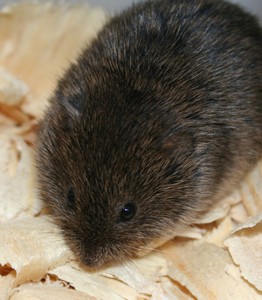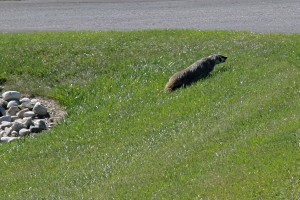Badgers
Yes, we have seen these guys around. This one was at our south entrance a while back!
Coyotes
We all hear the racket at night when there is a pack moving through and are aware that the coyotes are a part of living here; so just a few pointers gleaned from various web sites:
Walk with a walking stick or Carry noise makers, a whistle or rocks to throw
Keep pets on a short leash
Do not allow dogs to interact with coyotes
If approached with your dog – If a coyote is sighted, while walking your dog, make sure the dog is on a short leash and leave the area. While taking the dog away, the coyote may circle or follow you and your dog until you have left its territory. You can try shouting and waving off the coyote, however, it may have little effect. If your dog gets into a fight with a coyote, do not try to separate them with your hands. Use a long stick or throw something at the coyote.
Use extra caution dusk through dawn
Avoid known or potential den sites and thick vegetation
If you meet a coyote, make it feel unwelcome by yelling, throwing rocks and sticks at it, spraying it with a hose or a vinegar-filled water gun, or banging pots and pans
NEVER feed or throw food at coyotes
Do NOT turn your back on it, ignore it or run away
NEVER try to pet or touch it
NEVER move towards it, or corner it where it can’t run away
YELL and make a lot of noise while slowly moving towards other people
Make eye contact and make your self look bigger-raise your arms high, hold up your jacket or backpack
If a coyote moves towards you, throw sticks or rocks towards it, KEEP YELLING
Voles??
A few of our neighbours have been battling some tiny little varmints in their garages this winter. They are smaller than a mouse and have a long snout like a mole. We suspect they are Voles but our resident experts aren’t certain. If they are Voles we’re told our cats won’t hunt them – they are mean little beggars and probably not very good eating. Our old cat was an expert mouser but she avoided Voles
Apparently they love peanut butter and a little dab on a trap will do the trick.
Maybe check out your RV’s, like mice, they can get in to everything and cause big messes.

There’s a great section on Voles in the Deer and Other nuisance animals section along with loads of other information
Those Pesky Gophers
Even though the snow is still around we all know that these little guys will be poking their noses out soon. Apparently, the males are the first to appear and catching them early makes sure there are no Mom’s & babes around later.
This Alberta Agriculture article might help with our annual quest. Check it out Gopher Tales
What WON’T Deer Eat????
When you search the web for plants that deer don’t eat you will find a webpage that gives a list of 70 plants that are …. DEER RESISTANT Super! you say, let’s plant those.
BUT then you start reading various blogs from people with deer experience and find out that even the plants on the list aren’t safe. One lady says it best…”talk to your neighbors and see what is working for them at the moment, I say moment because where I live, just because momma won’t eat something doesn’t mean baby won’t. What they eat one year may change the next year, what they haven’t touched for 6 years they now find they love it. Different year, different herd of deer, things will constantly change.”
From the Alberta Government Shelterbelt Program web… “A well-trained dog may be man’s best friend in deterring deer in a new planting. Commercially developed deer repellents are also available but are generally expensive and require regular reapplication to remain effective. Home remedies include regular bath soap and/or human hair suspended at intervals along your planting may work to some degree. Spruce and Pine are among the least desirable food sources for deer. Paper Birch, Red Osier Dogwood, Red Elder Berry, and common Lilac rate low on the deer food menu. However, if the available browse is low, then deer will attempt almost any plant as a potential food source.”
As far as we can tell, everything the moose haven’t munched on the deer will devour and vice versa. Let’s see our deer and moose have eaten our hosta’s, Maple trees, Red Osier Dogwood, Red Elderberry, Ohio Buckeye, Baby spruce and pine and Cotoneasters BUT they don’t like Royalty Preston Lilacs or Saskatoons (so far). Jackie has even had a moose with it’s head in her front garden eating her cedars…
Have you found anything that grows or works? Let us know and we’ll pass it along.
Holey Moley
Our yards are starting to fill up with mole volcanoes again (argh!) so we thought some research was in order.
Moles live underground and surface only occasionally. The adult mole can measure anywhere from 12 to 20 cm in length and have dark grey or brown velvety fur. Its eyes are small and its broad front feet have strong claws for digging. Their cylindrical bodies and powerful front claws are ideal for digging. Moles burrow close to the surface, often leaving visible ridges. Mole hills are places where the mole has pushed up earth above the surface; new mole hills appear during periods when the soil is damp – generally spring and autumn.
Moles are insectivores. Most moles do not eat plants, but feed mainly on earthworms (their favorite food), insect larvae and arthropods (insects and crustaceans) that they find by the sense of touch. Some moles may eat tubers and the roots of garden plants.
Moles do not hibernate but remain active day or night all year long. During the winter, the mole will continue its quest for food deep below the frost line. Surface activity occurs most consistently in the spring and fall. Moles are solitary animals, and it is likely that only one or two moles are responsible for the damage to your lawn or garden.
Moles have only one litter of 3 to 4 young in the spring. These young will stay with the female in her tunnels for about a month, and then will start creating their own tunnels, reaching adult size in about four to eight weeks. The young may stay in the area several months after they have been weaned before finding their own territory. Young females will not breed until the following year.
Control
According to Pest control Canada, the most effective way to get rid of moles is to trap them. Injecting gas, flooding the tunnels or using poisons are rarely effective. Various traps can be purchased and according to our local experts (Ralph & Bill) there is a bit of an art in finding the mouth in the volcanoe (patience and the right size dowel help immensely). Once you figure it out though, you’re in trapping mode. Of course, a professional will guarantee to rid your property of these pests….at least until others move in.



